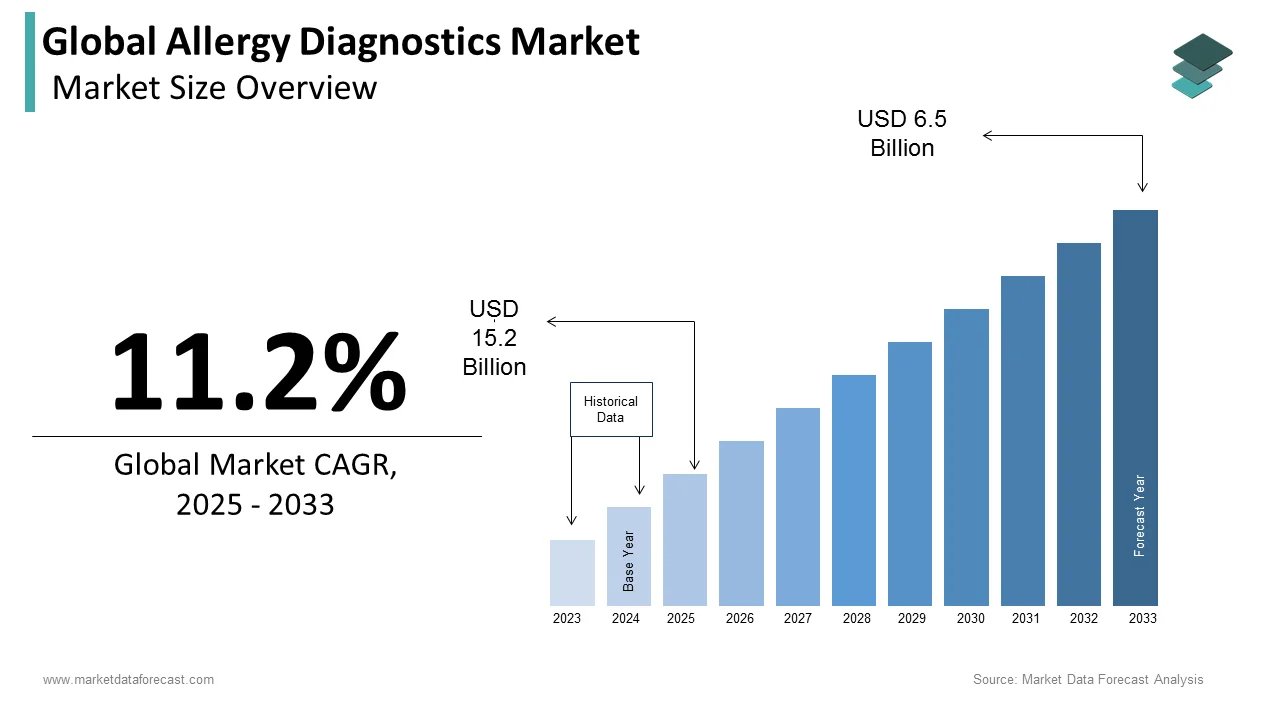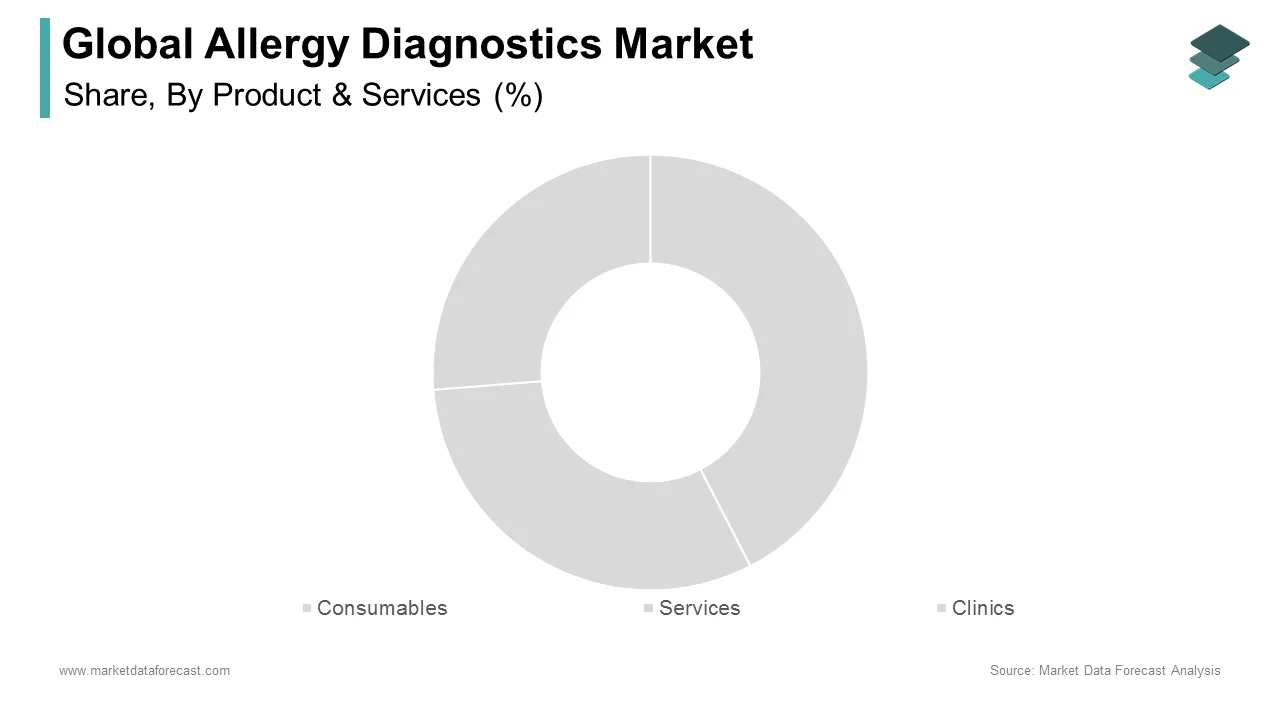Global Allergy Diagnostics Market Size, Share, Trends & Growth Forecast Report By Products & Services, Allergen Type, Test Type, End Users and Region (North America, Europe, Asia-Pacific, Latin America, Middle East and Africa), Industry Analysis From 2025 To 2033.
Global Allergy Diagnostics Market Size
The global allergy diagnostics market was worth US$ 5.85 billion in 2024 and is anticipated to reach a valuation of US$ 15.2 billion by 2033 from US$ 6.5 billion in 2025, and it is predicted to register a CAGR of 11.2% during the forecast period 2025-2033.

The recent allergy tests are more suitable and accurate than those available before. With the help of an individual's detailed medical history, allergy tests can quickly identify the cause of the allergy. This technology is required for drug development and the initial process of allergy treatments. The allergy diagnostics market is developing its performance levels in hospitals by providing efficient results in less time and allowing an easy diagnosis process for fewer pain patients. In addition, these tests are best for babies.
MARKET DRIVERS
The growing incidence of allergies worldwide, rising pollution levels, and increasing spending on healthcare are propelling the global allergy diagnostics market growth.
The number of allergic patients around is increasing tremendously, and it is estimated the same will continue in the coming future. The World Allergy Organization (WAO) estimates that every country's allergy incidence will turn 15% to 40% by 2030. The American College of Allergy, Asthma, and Immunology (ACAAI) stated that over 50 million Americans are affected by various allergies yearly. According to a 2014 report published by National Health Interview Survey (NHIS), In the United States, over 8% of children under 18 suffered from hay fever, 10% from respiratory allergies, 5.4% from food allergies, and 11.6% from skin allergies. The statistics above show that the global allergy diagnostics market will grow tremendously in the coming years.
In addition, growing environmental pollution and the hazardous lifestyle changes of the population are the two major factors driving the growth of the global allergy diagnostics market. On the other hand, food allergens continue to show the fastest growth rate due to ignorance in individuals, propelling the market's growth. Furthermore, the change in lifestyle and the consumption of junk foods, especially among youth, are lavishing the global allergy diagnostics market growth.
Furthermore, the emerging advanced technology shows excellent growth opportunities for the market by introducing various blood tests and lowering the risk. In addition, the government's increased support in launching reimbursement schemes for the poor is surging the global allergy diagnostics market demand.
MARKET RESTRAINTS
High costs associated and strict regulatory guidelines are majorly hindering the market’s growth rate. For example, installing and maintaining allergy diagnostic devices in laboratories is expensive. In addition, the lack of expertise in analyzing the reports and providing proper diagnoses has remained a challenging factor in the market growth.
REPORT COVERAGE
|
REPORT METRIC |
DETAILS |
|
Market Size Available |
2024 – 2033 |
|
Base Year |
2024 |
|
Forecast Period |
2025 to 2033 |
|
CAGR |
11.2% |
|
Segments Covered |
By Products & Services, Test Type, Allergen, End Users, and Region. |
|
Various Analyses Covered |
Global, Regional, and country-level analysis; Segment-Level Analysis, DROC; PESTLE Analysis; Porter’s Five Forces Analysis, Competitive Landscape; Analyst Overview of Investment Opportunities |
|
Regions Covered |
North America, Europe, APAC, Latin America, Middle East & Africa |
|
Market Leaders Profiled |
Thermo Fisher Scientific Inc. (United States), Siemens AG (Germany), Danaher Corporation (United States), Omega Diagnostics Group PLC (United Kingdom), Hitachi Chemical Co., Ltd. (Japan), bioMérieux SA (France), Stallergenes Greer (United Kingdom), HOB Biotech Group Suzhou Co., Ltd. (China), HYCOR Biomedical (United States) and Lincoln Diagnostics, Inc. (United States)., and Others. |
SEGMENTAL ANALYSIS
By Product & Services Insights

The consumables segment is forecasted to account for the largest share of the global allergy diagnostics market based on the product and service during the forecast period. The segment's growth is attributed to the widespread availability and colossal consumption of consumables; the low cost associated with the diagnostic of allergies in allergy testing is projected to propel the segment’s growth.
The instruments segment is estimated to have the fastest global allergy diagnostics market growth over the forecast period. The segment’s growth is majorly driven by the technological advancements that offer individualized patient profiling and monitoring.
By Test Type Insights
Based on test type, the in-vivo segment had the largest share of the global allergy diagnostics market in 2024 and is projected to grow at a CAGR of 11% during the forecast period. The segmental growth is primarily driven by the associated advantages such as ease of use, time efficiency, broad accessibility, and sensitivity for clinically valid allergies.
The in-vitro segment is projected to witness the highest CAGR during the forecast period owing to the growing demand for less invasive diagnostic methods, lab automation, and highly sensitive and correct results. In addition, the growing focus of the market participants to provide allergic-specific solutions and efficient result-oriented devices to strengthen their position in the global allergy diagnostics market is expected to boost segmental growth.
By Allergen Insights
Based on allergens, the inhaled allergens segment had a significant share of the global allergy diagnostics market in 2024 and is estimated to showcase healthy CAGR during the forecast period owing to the growing incidence of respiratory allergies and asthma worldwide, high demand for allergy testing, and the introduction of a particular allergy for the analysis. Moreover, growing global environmental pollution levels over the market propel segmental growth.
The food allergens segment is predicted to showcase the highest CAGR during the forecast period. This is because many deaths are happening worldwide due to food allergies. According to How Stuff Works, 150 to 200 people in the United States and more than ten people in the United Kingdom die from food allergies yearly. Therefore, the inhaled allergen segment will witness decent growth in the mentioned forecast period in the same line.
By End User Insights
Based on the end-user, the diagnostic laboratories segment dominated the global allergy diagnostics market in 2024 and is forecasted to register a promising CAGR in the coming years.
REGIONAL ANALYSIS
The North American allergy diagnostics market had a significant global market share in 2024.
The increased incidences of allergies due to a drastic change in lifestyle and food habits are propelling the growth of the North American allergy diagnostics market. Within North America, the United States held the majority of the shares. Growing allergies due to a drastic change in lifestyle and food habits propel the market's growth in this region. For instance, according to a 2017 report, an increase of 21% has been noted in peanut allergies in the United States.
The Asia Pacific allergy diagnostics market is projected to grow at the fastest CAGR during the forecast period owing to the increased scale of hospitals with well-equipped laboratories and the awareness of the treatment procedures. On the other hand, Europe will have a tremendous growth rate in the coming years. The allergy diagnostics market in Asia expects a high growth rate in the coming years due to increasing incidents of allergic diseases, updated infrastructure, and the aging population in the region. In addition, the rise in pollution across the globe is expected to drive the global allergy diagnostic market. As well as the increasing global population can also be the primary driver of this market. However, high capital requirements and stringent regulations by various countries’ governments are major restraining factors affecting the market's growth. The rapidly increasing population of countries such as India and China is expected to drive the Asia region market.
The allergy diagnostics market in Europe is estimated to perform well during the forecast period. Allergy-related diseases are increasing in this region. As per EAACI (European Academy of Allergy and Clinical Immunology), over 150 million of the population currently have chronic allergic diseases, estimated to occupy 50% of Europe's entire population by the year 2050. Around 7+ million population are suffering from various food allergies on this continent. The incidence of allergies in the United Kingdom is very high, with over 20% of its population having one or more allergic conditions.
KEY MARKET PARTICIPANTS
Some of the notable players dominating the global allergy diagnostics market profiled in this report are Thermo Fisher Scientific Inc. (United States), Siemens AG (Germany), Danaher Corporation (United States), Omega Diagnostics Group PLC (United Kingdom), Hitachi Chemical Co., Ltd. (Japan), bioMérieux SA (France), Stallergenes Greer (United Kingdom), HOB Biotech Group Suzhou Co., Ltd. (China), HYCOR Biomedical (United States) and Lincoln Diagnostics, Inc. (United States).
RECENT MARKET DEVELOPMENTS
- In March 2019, Hitachi Chemical Diagnostics accepted 510 (K) for its OPTIGEN AP 3600, and the FDA approved this product. The product is designed with a high volume of testing allergic instruments and offers. In addition, the automated system is featured with continuing and convenient use and provides the medical expert’s ad fronting screening camouflage and cover-up for panel allergy diagnosis.
- In December 2018, Hycor Biomedical Inc., a known manufacturer of in-vitro diagnostic products for allergy and autoimmune testing, publicly stated that it had received 510 (K) for NOVELS, an allergy testing system. The company has also obtained clearance for the system’s 1st specific IgE assay to identify Dust Mite allergens and has concentrated on developing more tests to offer a complete menu to the customers.
- In April 2014, Greer Laboratories publicly stated that it had accepted ORALAIR, an immunotherapy tablet used for sublingual allergy purposes. It is for the treatment of grass-pollen-influenced allergic rhinitis with or without conjunctivitis.
MARKET SEGMENTATION
This market research report on the global allergy diagnostics market has been segmented and sub-segmented based on products & services, test type, allergen, end-users, and region.
By Product & Services
- Consumables
- Instruments
- Immunoassay Analyzers
- Luminometers
- ELISA Analyzers
- Other Instruments
- Services
By Test Type
- In-Vivo Tests
- In-Vitro Tests
By Allergen
- Inhaled Allergens
- Food Allergens
- Drug Allergens
- Other Allergens
By End User
- Diagnostics Laboratories
- Hospital-based Laboratories
- Academic and Research Institutes
By Region
- North America
- Europe
- Asia Pacific
- Latin America
- Middle East and Africa
Frequently Asked Questions
How big is the allergy diagnostics market?
The global allergy diagnostics market size was valued at USD 5.85 billion in 2024.
Which segment by allergen type occupied leading share of the allergy diagnostics market in 2024?
Based on allergen type, the inhaled allergens segment had the dominating share of the global allergy diagnostics market in 2024.
Which region had the largest share of the global allergy diagnostics market in 2024?
North America dominated the allergy diagnostics market in 2024.
Which are the companies playing a key role in the global allergy diagnostics market?
Thermo Fisher Scientific Inc. (United States), Siemens AG (Germany), Danaher Corporation (United States), Omega Diagnostics Group PLC (United Kingdom), Hitachi Chemical Co., Ltd. (Japan), bioMérieux SA (France), Stallergenes Greer (United Kingdom), HOB Biotech Group Suzhou Co., Ltd. (China), HYCOR Biomedical (United States) and Lincoln Diagnostics, Inc. (United States) are some of the notable companies in the allergy diagnostics market.
Related Reports
Access the study in MULTIPLE FORMATS
Purchase options starting from $ 2500
Didn’t find what you’re looking for?
TALK TO OUR ANALYST TEAM
Need something within your budget?
NO WORRIES! WE GOT YOU COVERED!
Call us on: +1 888 702 9696 (U.S Toll Free)
Write to us: [email protected]

